MITSUBISHI ECLIPSE CROSS 2020 Owner's Manual (in English)
Manufacturer: MITSUBISHI, Model Year: 2020, Model line: ECLIPSE CROSS, Model: MITSUBISHI ECLIPSE CROSS 2020Pages: 427, PDF Size: 78.05 MB
Page 321 of 427
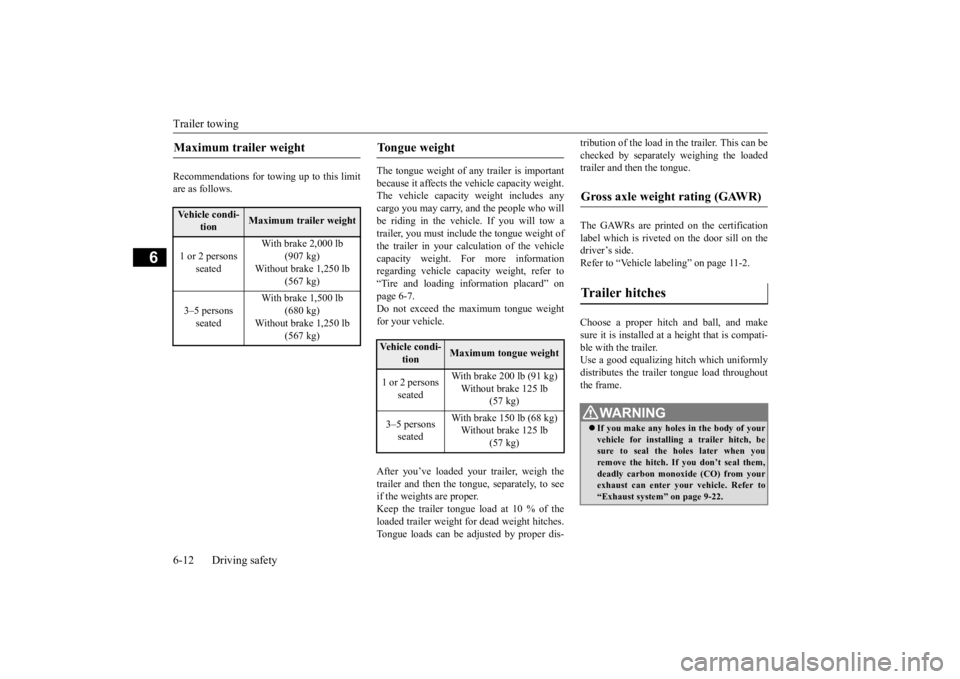
Trailer towing 6-12 Driving safety
6
Recommendations for towing up to this limit are as follows.
The tongue weight of any trailer is important because it affects the vehicle capacity weight. The vehicle capacity weight includes anycargo you may carry, and the people who will be riding in the vehicle. If you will tow a trailer, you must include the tongue weight ofthe trailer in your calculation of the vehicle capacity weight. For more information regarding vehicle capacity weight, refer to“Tire and loading information placard” onpage 6-7. Do not exceed the maximum tongue weight for your vehicle. After you’ve loaded your trailer, weigh the trailer and then the tongue, separately, to see if the weights are proper.Keep the trailer tongue load at 10 % of the loaded trailer weight for dead weight hitches. Tongue loads can be adjusted by proper dis-
tribution of the load in the trailer. This can be checked by separately weighing the loaded trailer and then the tongue. The GAWRs are printed on the certification label which is riveted on the door sill on the driver’s side.Refer to “Vehicle labeling” on page 11-2. Choose a proper hitch and ball, and make sure it is installed at a height that is compati-ble with the trailer. Use a good equalizing hitch which uniformly distributes the trailer tongue load throughoutthe frame.
Maximum trailer weight Vehicle condi-
tion
Maximum trailer weight
1 or 2 persons
seated
With brake 2,000 lb
(907 kg)
Without brake 1,250 lb
(567 kg)
3–5 persons
seated
With brake 1,500 lb
(680 kg)
Without brake 1,250 lb
(567 kg)
Tongue weight Vehicle condi-
tion
Maximum tongue weight
1 or 2 persons
seated
With brake 200 lb (91 kg) Without brake 125 lb
(57 kg)
3–5 persons
seated
With brake 150 lb (68 kg) Without brake 125 lb
(57 kg)
Gross axle weight rating (GAWR) Trailer hitches
WA R N I N G If you make any holes in the body of your vehicle for installing a trailer hitch, be sure to seal the holes later when you remove the hitch. If you don’t seal them, deadly carbon monoxide (CO) from your exhaust can enter your
vehicle. Refer to
“Exhaust system” on page 9-22.
BK0277700US.bo
ok 12 ページ 2019年3月8日 金曜日 午前9時23分
Page 322 of 427
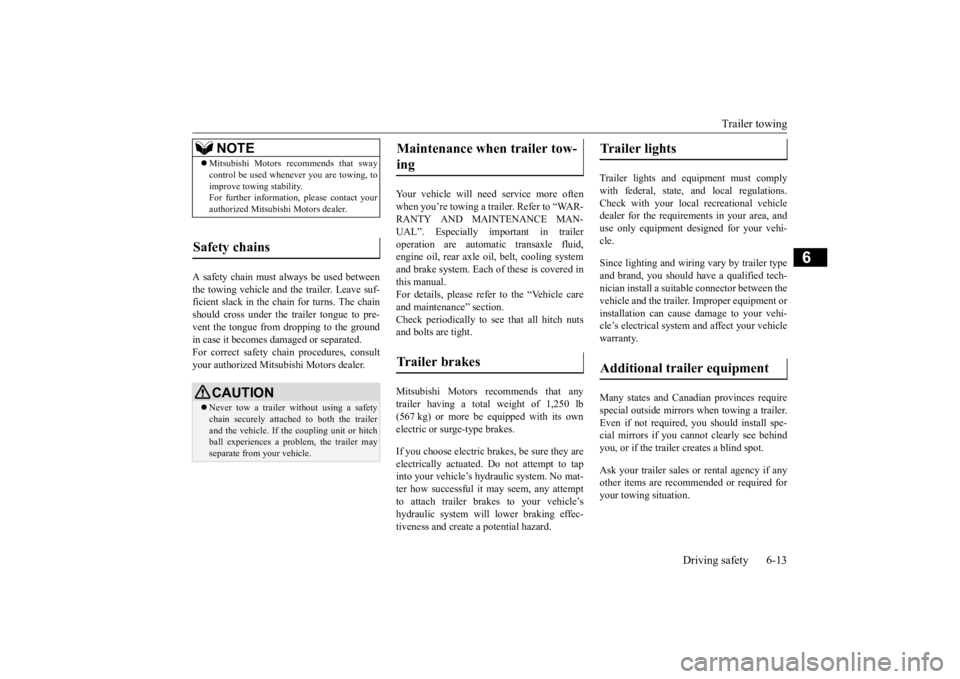
Trailer towing
Driving safety 6-13
6
A safety chain must always be used between the towing vehicle and the trailer. Leave suf- ficient slack in the chain for turns. The chain should cross under the trailer tongue to pre-vent the tongue from dropping to the ground in case it becomes damaged or separated. For correct safety chain procedures, consultyour authorized Mitsubishi Motors dealer.
Your vehicle will need service more often when you’re towing a trailer. Refer to “WAR- RANTY AND MAINTENANCE MAN- UAL”. Especially important in traileroperation are automatic transaxle fluid, engine oil, rear axle oil, belt, cooling system and brake system. Each of these is covered inthis manual.For details, please refer to the “Vehicle care and maintenance” section. Check periodically to see that all hitch nutsand bolts are tight. Mitsubishi Motors recommends that any trailer having a total weight of 1,250 lb (567 kg) or more be equipped with its own electric or surge-type brakes. If you choose electric brakes, be sure they are electrically actuated. Do not attempt to tap into your vehicle’s hydraulic system. No mat- ter how successful it may seem, any attemptto attach trailer brakes to your vehicle’s hydraulic system will lower braking effec- tiveness and create a potential hazard.
Trailer lights and equipment must comply with federal, state, and local regulations.Check with your local recreational vehicle dealer for the requirements in your area, and use only equipment designed for your vehi-cle. Since lighting and wiring vary by trailer type and brand, you should have a qualified tech- nician install a suitable connector between the vehicle and the trailer. Improper equipment orinstallation can cause damage to your vehi- cle’s electrical system and affect your vehicle warranty. Many states and Canadian provinces require special outside mirrors when towing a trailer.Even if not required, you should install spe- cial mirrors if you cannot clearly see behind you, or if the trailer creates a blind spot. Ask your trailer sales or rental agency if any other items are recommended or required for your towing situation.
NOTE
Mitsubishi Motors recommends that sway control be used when
ever you are towing, to
improve towing stability. For further information, please contact your authorized Mitsubishi Motors dealer.
Safety chains
CAUTION Never tow a trailer without using a safety chain securely attached to both the trailer and the vehicle. If the coupling unit or hitch ball experiences a problem, the trailer may separate from your vehicle.
Maintenance when trailer tow- ing Trailer brakes
Trailer lights Additional trailer equipment
BK0277700US.bo
ok 13 ページ 2019年3月8日 金曜日 午前9時23分
Page 323 of 427
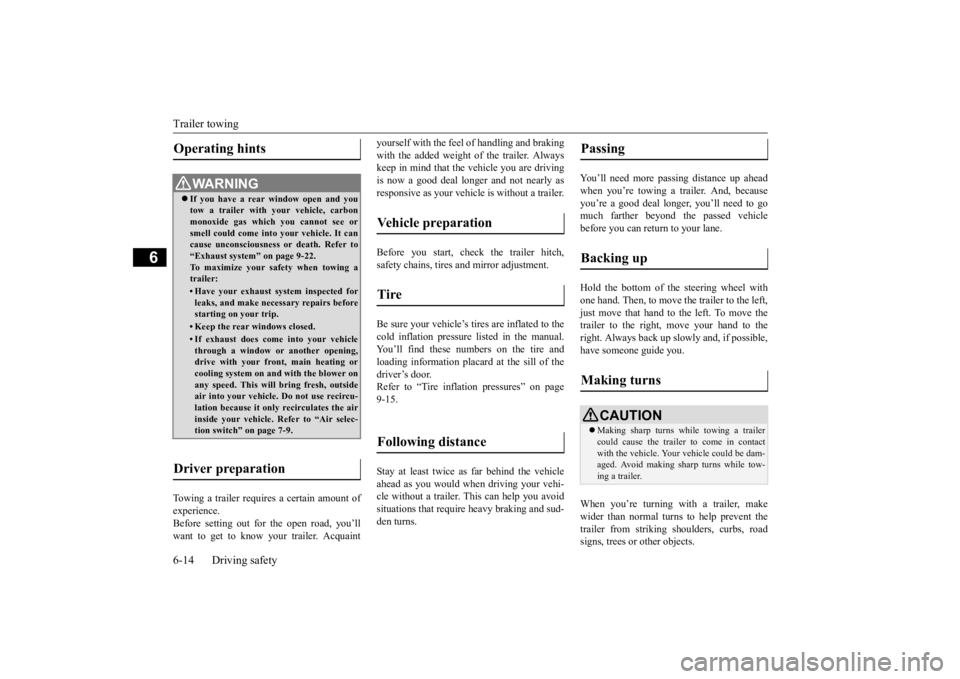
Trailer towing 6-14 Driving safety
6
Towing a trailer requires a certain amount of experience. Before setting out for the open road, you’llwant to get to know your trailer. Acquaint
yourself with the feel
of handling and braking
with the added weight of the trailer. Always keep in mind that the vehicle you are driving is now a good deal longer and not nearly asresponsive as your vehicle is without a trailer. Before you start, check the trailer hitch, safety chains, tires and mirror adjustment. Be sure your vehicle’s tires are inflated to the cold inflation pressure listed in the manual.You’ll find these numbers on the tire and loading information placard at the sill of the driver’s door.Refer to “Tire inflation pressures” on page 9-15. Stay at least twice as far behind the vehicle ahead as you would when driving your vehi-cle without a trailer. This can help you avoid situations that require heavy braking and sud- den turns.
You’ll need more passing distance up ahead when you’re towing a trailer. And, becauseyou’re a good deal longer, you’ll need to go much farther beyond the passed vehicle before you can return to your lane. Hold the bottom of the steering wheel with one hand. Then, to move the trailer to the left, just move that hand to the left. To move thetrailer to the right, move your hand to the right. Always back up slowly and, if possible, have someone guide you. When you’re turning with a trailer, make wider than normal turns to help prevent thetrailer from striking shoulders, curbs, road signs, trees or other objects.
Operating hints
WA R N I N G If you have a rear window open and you tow a trailer with your vehicle, carbon monoxide gas which you cannot see or smell could come into your vehicle. It cancause unconsciousness or death. Refer to “Exhaust system” on page 9-22. To maximize your safety when towing atrailer:• Have your exhaust system inspected forleaks, and make necessary repairs before starting on your trip.• Keep the rear windows closed.• If exhaust does come into your vehicle through a window or another opening, drive with your front, main heating or cooling system on and with the blower onany speed. This will bring fresh, outside air into your vehicle. Do not use recircu- lation because it only recirculates the airinside your vehicle. Refer to “Air selec- tion switch” on page 7-9.
Driver preparation
Vehicle preparation Tire Following distance
Passing Backing up Making turns
CAUTION Making sharp turns while towing a trailer could cause the trailer to come in contact with the vehicle. Your vehicle could be dam- aged. Avoid making sharp turns while tow-ing a trailer.
BK0277700US.bo
ok 14 ページ 2019年3月8日 金曜日 午前9時23分
Page 324 of 427
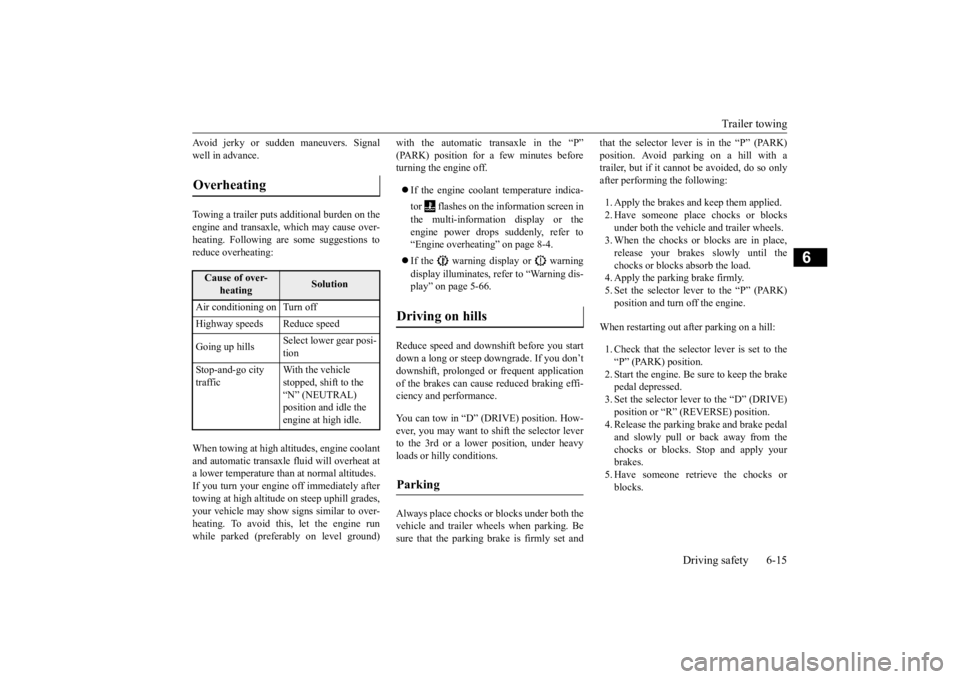
Trailer towing
Driving safety 6-15
6
Avoid jerky or sudden maneuvers. Signal well in advance. Towing a trailer puts additional burden on the engine and transaxle, which may cause over- heating. Following are some suggestions to reduce overheating: When towing at high altitudes, engine coolant and automatic transaxle fluid will overheat at a lower temperature than at normal altitudes.If you turn your engine off immediately after towing at high altitude on steep uphill grades, your vehicle may show signs similar to over-heating. To avoid this
, let the engine run
while parked (preferably on level ground)
with the automatic transaxle in the “P” (PARK) position for a few minutes before turning the engine off. If the engine coolant temperature indica- tor flashes on the information screen in the multi-information display or the engine power drops suddenly, refer to “Engine overheating” on page 8-4. If the warning display or warning display illuminates, refer to “Warning dis- play” on page 5-66.
Reduce speed and downshift before you start down a long or steep
downgrade. If you don’t
downshift, prolonged or frequent applicationof the brakes can cause reduced braking effi- ciency and performance. You can tow in “D” (DRIVE) position. How- ever, you may want to shift the selector leverto the 3rd or a lower position, under heavy loads or hilly conditions. Always place chocks or blocks under both the vehicle and trailer wheels when parking. Be sure that the parking brake is firmly set and
that the selector lever is in the “P” (PARK) position. Avoid parking on a hill with a trailer, but if it cannot be avoided, do so only after performing the following: 1. Apply the brakes and keep them applied. 2. Have someone place chocks or blocks under both the vehicle and trailer wheels. 3. When the chocks or blocks are in place,release your brakes slowly until the chocks or blocks absorb the load. 4. Apply the parking brake firmly.5. Set the selector lever to the “P” (PARK)position and turn off the engine.
When restarting out after parking on a hill: 1. Check that the selector lever is set to the “P” (PARK) position. 2. Start the engine. Be sure to keep the brakepedal depressed. 3. Set the selector lever to the “D” (DRIVE) position or “R” (REVERSE) position.4. Release the parking brake and brake pedal and slowly pull or
back away from the
chocks or blocks. Stop and apply yourbrakes. 5. Have someone retrieve the chocks or blocks.
Overheating
Cause of over-
heating
Solution
Air conditioning on Turn off Highway speeds Reduce speed Going up hills
Select lower gear posi- tion
Stop-and-go city traffic
With the vehicle stopped, shift to the “N” (NEUTRAL) position and idle the engine at high idle.
Driving on hills Parking
BK0277700US.bo
ok 15 ページ 2019年3月8日 金曜日 午前9時23分
Page 325 of 427

BK0277700US.book 16 ページ 2019年3月8日 金曜日 午前9時23分
Page 326 of 427
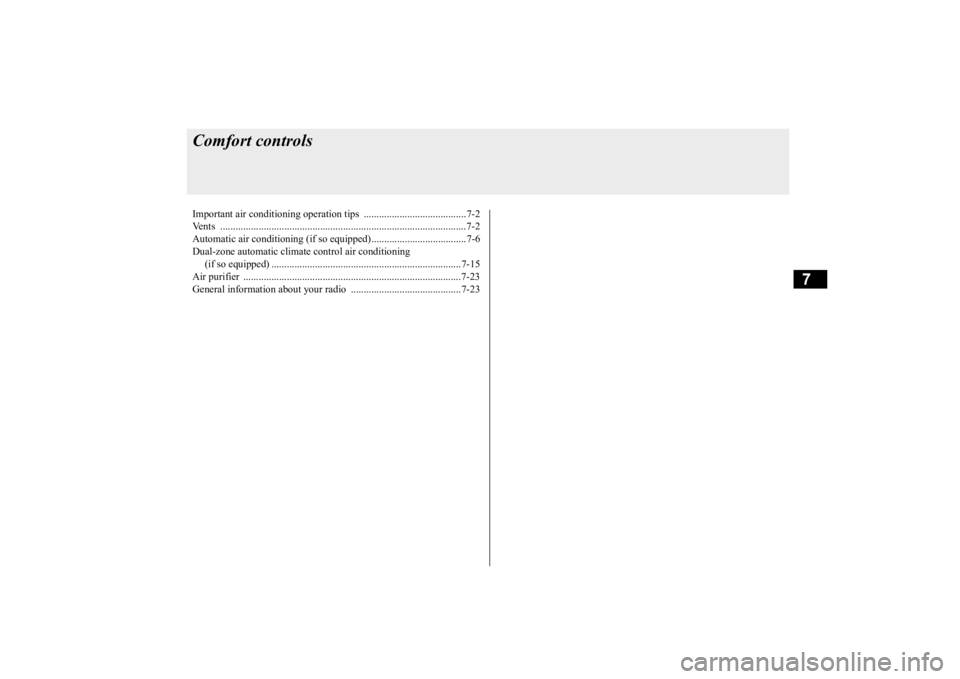
7
Comfort controlsImportant air conditioning op
eration tips ........................................7-2
Vents .........................................
.......................................................7-2
Automatic air conditioning (if so equipped).....................................7-6 Dual-zone automatic climate control air conditioning (if so equipped) .
.................................................
........................7-15
Air purifier ......................
...............................................................7-23
General information about
your radio ...........................................7-23
BK0277700US.bo
ok 1 ページ 2019年3月8日 金曜日 午前9時23分
Page 327 of 427
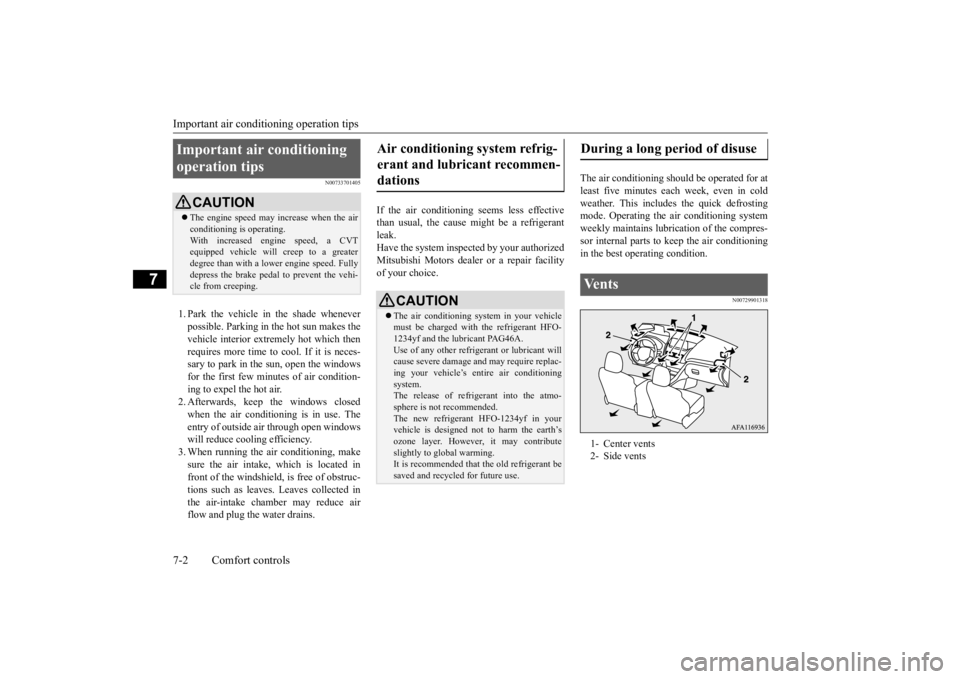
Important air conditioning operation tips 7-2 Comfort controls
7
N00733701405
1. Park the vehicle in the shade whenever possible. Parking in the hot sun makes thevehicle interior extremely hot which then requires more time to cool. If it is neces- sary to park in the sun, open the windowsfor the first few minutes of air condition- ing to expel the hot air. 2. Afterwards, keep the windows closedwhen the air conditioning is in use. The entry of outside air through open windows will reduce cooling efficiency.3. When running the air conditioning, make sure the air intake, which is located in front of the windshield, is free of obstruc-tions such as leaves. Leaves collected in the air-intake chamber may reduce air flow and plug the water drains.
If the air conditioning seems less effective than usual, the cause might be a refrigerant leak.Have the system inspected by your authorized Mitsubishi Motors dealer or a repair facility of your choice.
The air conditioning should be operated for at least five minutes each week, even in coldweather. This includes the quick defrosting mode. Operating the air conditioning system weekly maintains lubrication of the compres-sor internal parts to keep the air conditioning in the best operating condition.
N00729901318
Important air conditioning operation tips
CAUTION The engine speed may increase when the air conditioning is operating. With increased engine speed, a CVT equipped vehicle will creep to a greaterdegree than with a lower engine speed. Fully depress the brake pedal to prevent the vehi- cle from creeping.
Air conditioning system refrig- erant and lubricant recommen- dations
CAUTION The air conditioning system in your vehicle must be charged with the refrigerant HFO-1234yf and the lubricant PAG46A. Use of any other refrigerant or lubricant will cause severe damage and may require replac-ing your vehicle’s entire air conditioning system. The release of refrigerant into the atmo-sphere is not recommended. The new refrigerant HFO-1234yf in your vehicle is designed not to harm the earth’sozone layer. However, it may contribute slightly to global warming. It is recommended that the old refrigerant be saved and recycled for future use.
During a long period of disuse Ve n t s 1- Center vents 2- Side vents
BK0277700US.bo
ok 2 ページ 2019年3月8日 金曜日 午前9時23分
Page 328 of 427
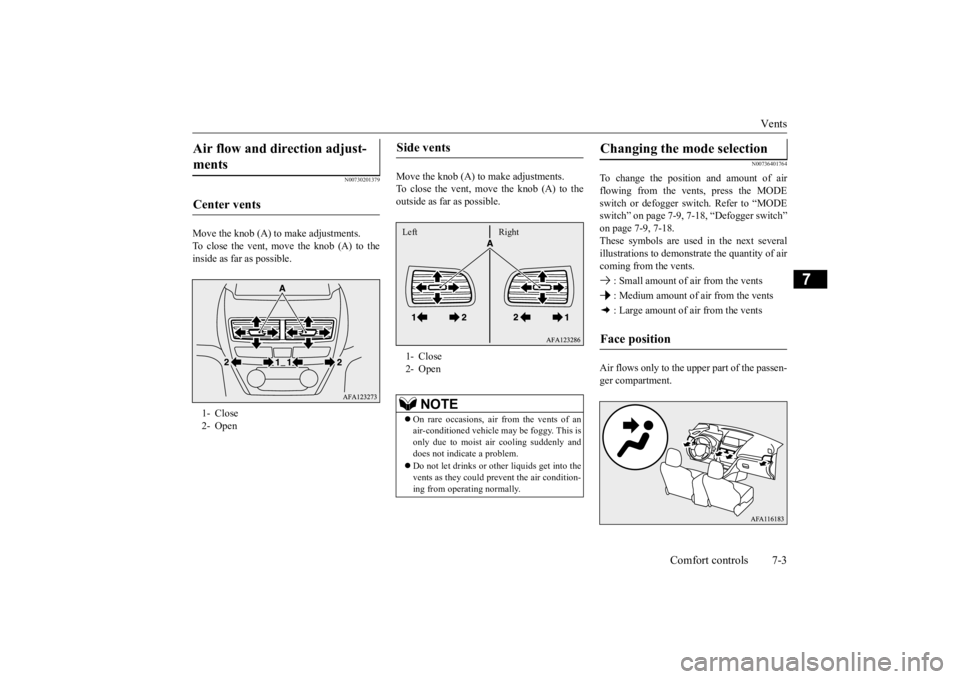
Vents
Comfort controls 7-3
7
N00730201379
Move the knob (A) to make adjustments. To close the vent, move the knob (A) to the inside as far as possible.
Move the knob (A) to make adjustments. To close the vent, move the knob (A) to theoutside as far as possible.
N00736401764
To change the position and amount of airflowing from the vents, press the MODEswitch or defogger switch. Refer to “MODE switch” on page 7-9, 7-18, “Defogger switch” on page 7-9, 7-18.These symbols are used in the next several illustrations to demonstrate the quantity of air coming from the vents. : Small amount of air from the vents : Medium amount of air from the vents : Large amount of air from the vents Air flows only to the upper part of the passen- ger compartment.
Air flow and direction adjust- ments Center vents 1- Close 2- Open
Side vents 1- Close2- Open
NOTE
On rare occasions, air from the vents of an air-conditioned vehicle may be foggy. This isonly due to moist air cooling suddenly and does not indicate a problem. Do not let drinks or ot
her liquids get into the
vents as they could prevent the air condition- ing from operating normally.Left Right
Changing the mode selection Face position
BK0277700US.bo
ok 3 ページ 2019年3月8日 金曜日 午前9時23分
Page 329 of 427
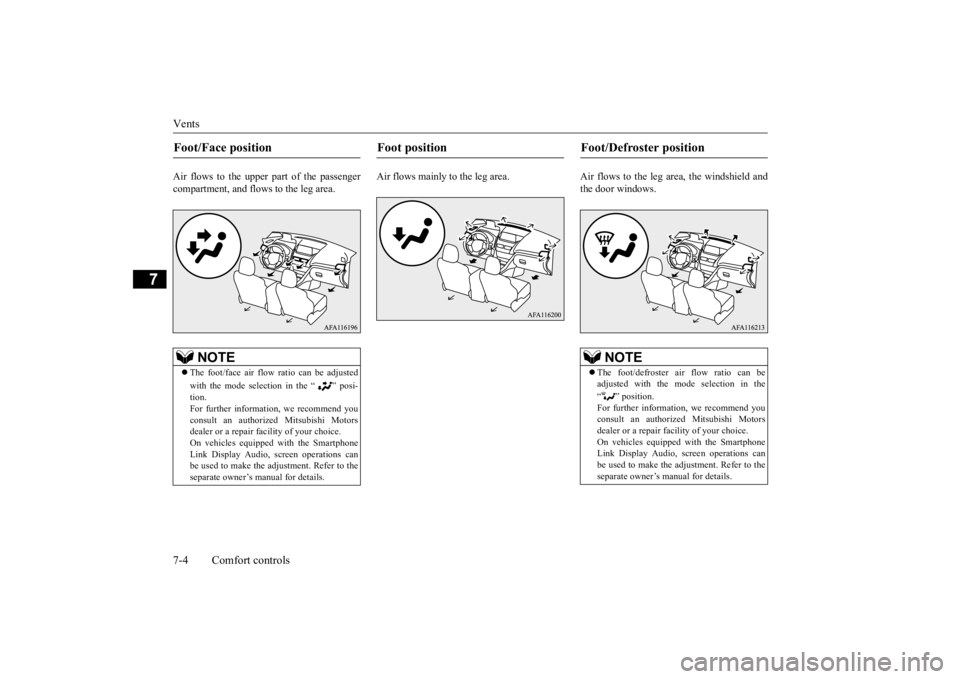
Vents 7-4 Comfort controls
7
Air flows to the upper part of the passenger compartment, and flows to the leg area.
Air flows mainly to the leg area. Air flows to the leg area, the windshield and
the door windows.
Foot/Face position
NOTE
The foot/face air flow ratio can be adjusted with the mode selection in the “ ” posi- tion. For further information, we recommend you consult an authorized Mitsubishi Motors dealer or a repair facility of your choice.On vehicles equipped with the Smartphone Link Display Audio, screen operations can be used to make the adjustment. Refer to theseparate owner’s manual for details.
Foot position
Foot/Defroster position
NOTE
The foot/defroster air flow ratio can be adjusted with the mode selection in the “ ” position. For further information, we recommend youconsult an authorized Mitsubishi Motors dealer or a repair facility of your choice. On vehicles equipped with the SmartphoneLink Display Audio, screen operations can be used to make the adjustment. Refer to the separate owner’s manual for details.
BK0277700US.bo
ok 4 ページ 2019年3月8日 金曜日 午前9時23分
Page 330 of 427
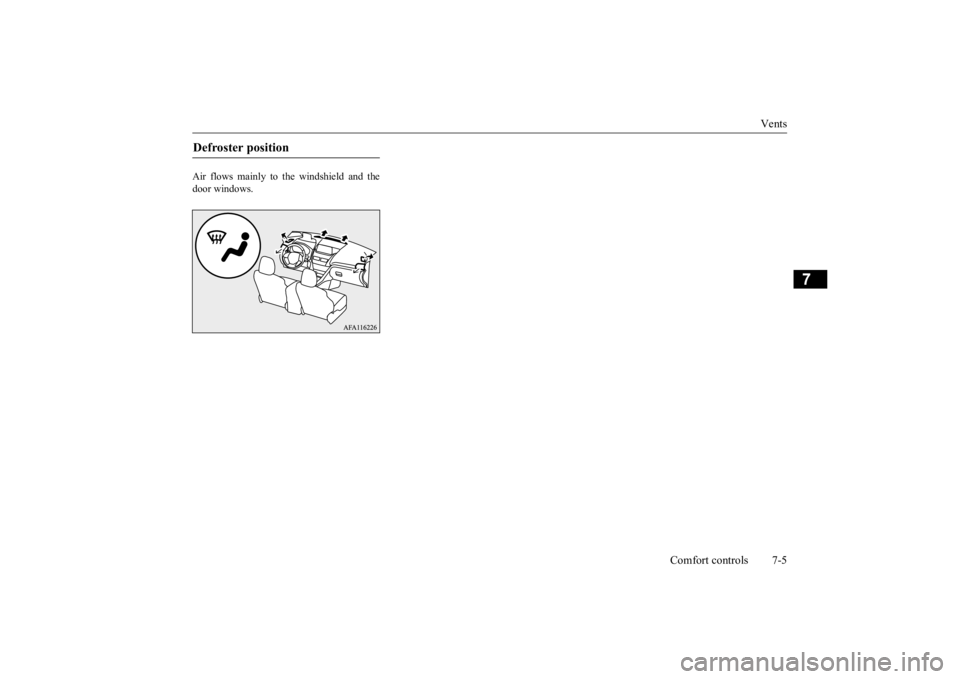
Vents
Comfort controls 7-5
7
Air flows mainly to the windshield and the door windows.Defroster position
BK0277700US.bo
ok 5 ページ 2019年3月8日 金曜日 午前9時23分